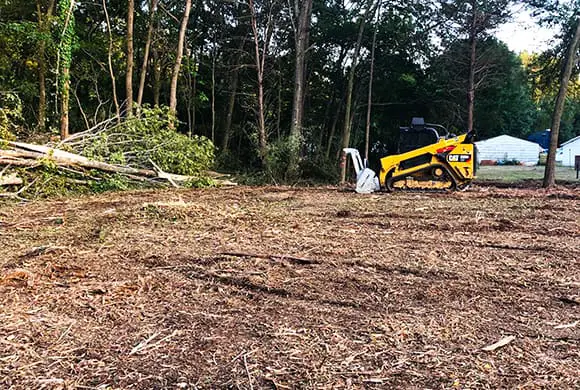What is The Most Efficient Method of Clearing Land for Agriculture?

Clearing land for agriculture is an essential step in preparing land for farming. The process involves removing trees, vegetation, rocks, and other obstructions from the land to create a suitable environment for growing crops.
While the process of clearing land may seem straightforward, the reality is that it requires careful planning and execution to achieve the best results. But with so many land clearing methods available, how do you know which one is the most efficient?
In this article, we’ll explore the most efficient method of clearing land for agriculture and the factors to consider when choosing the right technique for your needs.
Whether you’re a seasoned farmer or a beginner, this guide will provide you with valuable insights to help you make an informed decision. So, let’s dive in and discover the most efficient method of clearing land for agriculture!
The Importance of Land Clearing Land in Agriculture
Before embarking on the task of clearing land, it’s essential to understand why you’re doing it. The primary purpose of clearing land for agriculture is to create a space for farming activities. However, there are other reasons why you might want to clear land for agriculture, such as:
- Removing trees or vegetation that might impede construction or other developments
- Creating a buffer zone between forests and residential areas
- Creating space for recreational activities such as camping, hiking, or hunting
Regardless of the reason, the process of clearing land for agriculture has environmental implications that must be considered.
Clearing the Land Method
Once the site has been prepared, the process of clearing land for agriculture can begin. Depending on the chosen method of clearing, the process may involve different steps.
1. Manual Clearing
If you’ve decided to clear the land manually, the first step is to remove all small trees and vegetation using hand tools such as axes or machetes. Then, larger trees can be cut down using chainsaws or handsaws. The stumps can be removed using a stump grinder or by digging them out with an excavator.
2. Mechanical Clearing
If you’ve opted for mechanical clearing, the process typically involves using heavy equipment to clear the land. Bulldozers or backhoes can be used to push over trees and vegetation, and then they can be removed using excavators or loaders. This method is typically faster than manual clearing, but it can be more expensive.
3. Chemical Clearing
If you’ve chosen chemical clearing, herbicides can be applied to unwanted vegetation. The herbicides are typically sprayed over the area to be cleared, and then the vegetation dies off over a period of several weeks. This method is typically the most cost-effective but can have long-term environmental impacts.
4. Controlled Burning
This method involves setting controlled fires to clear land of vegetation. It can be efficient and cost-effective but requires specific conditions and safety measures.
5. Grazing Animals
This method involves using animals such as goats or sheep to clear land of vegetation. It can be a cost-effective method but may require additional management to prevent overgrazing.
6. Mulching
This method involves using a mulching machine to chop up vegetation and turn it into mulch. The mulch can be used as a natural fertilizer and weed suppressant. One of the primary advantages of forestry mulching land clearing is that it is a more cost-effective method of land clearing than traditional methods such as bulldozing or burning
7. Combination Methods
Depending on the land’s size, type of vegetation, and budget, a combination of methods may be used for more efficient and effective clearing. For example, manual clearing may be used to cut small trees, while mechanical clearing may be used for larger trees and shrubs.
What is The Most Efficient Method of Clearing Land for Agriculture?
Clearing land for agriculture is a critical task that farmers must undertake to cultivate crops and maximize yields. However, with so many different methods available, it can be challenging to determine the most efficient and effective approach. One option is to use a combination of methods, which can help optimize the clearing process and ensure the best possible results.
Depending on the size of the land, type of vegetation, and budget, a combination of methods may be used for more efficient and effective clearing. Manual clearing involves the use of hand tools such as machetes or chainsaws to remove small trees and shrubs, making it the most efficient method for smaller areas with less dense vegetation.
Mechanical clearing, on the other hand, involves the use of heavy machinery such as bulldozers for land clearing or bulldozer to remove stumps, and other obstacles from the land. It can be much faster and more efficient than manual clearing, allowing for a larger area to be cleared in a shorter amount of time. Mechanical clearing is the best option for larger areas with dense vegetation.
By combining manual and mechanical clearing methods, farmers can take advantage of the benefits of each approach while minimizing the drawbacks. Manual clearing may be used to remove smaller trees and shrubs, while mechanical clearing can be used for larger trees and other obstacles. This approach can help optimize the clearing process and ensure the best possible results.
In addition to manual and mechanical clearing, controlled burning may also be used as a complementary method. Controlled burning involves setting controlled fires to remove vegetation and clear the land. While not suitable for all situations, controlled burning can be an effective way to remove certain types of vegetation, particularly in areas where manual or mechanical clearing is not practical.
Assessing the Environmental Impact of Clearing Land
Clearing land for agriculture has both short-term and long-term environmental impacts. In the short term, it can lead to soil erosion, habitat loss for wildlife, and reduced water quality due to runoff. In the long term, it can contribute to climate change by releasing carbon into the atmosphere and reducing the land’s ability to sequester carbon.
To minimize the environmental impact of clearing land for agriculture, it’s essential to assess the site carefully. Factors to consider include soil type, topography, water availability, and the presence of endangered or threatened species. It’s also important to develop a plan for soil conservation and erosion control to ensure that the land remains fertile and productive in the long term.
Preparing the Site for Clearing
Before clearing the land, it’s important to prepare the site to ensure the process goes smoothly. Site preparation involves:
- Marking the boundaries of the land to be cleared
- Identifying and removing any hazardous materials such as old fences, debris, or abandoned structures
- Removing any obstacles that might impede the process of clearing, such as rocks or large roots
- Identifying and marking any valuable trees or vegetation that should be protected
- Obtaining any necessary permits or approvals from local authorities
By preparing the site, you can ensure that the process of clearing land for agriculture is efficient and effective.
Post-Clearing Site Maintenance and Management
Once the land has been cleared, it’s important to take steps to maintain and manage the site. This includes:
- Removing any remaining debris or stumps
- Grading the land to ensure proper drainage
- Planting cover crops or vegetation to prevent erosion and promote soil health
- Installing any necessary irrigation or drainage systems
- Fencing the area to keep out wildlife or prevent access by unauthorized individuals
- Monitoring the site for any signs of erosion, invasive species, or other issues that may need attention
By maintaining the site properly, you can ensure that the land remains productive and healthy for years to come.
Ongoing Sustainability Practices to Ensure Long-Term Success
To ensure long-term success, it’s essential to adopt sustainable practices when clearing land for agriculture. This includes:
- Using conservation tillage techniques to minimize soil disturbance and reduce erosion
- Planting cover crops or using crop rotation to improve soil health and prevent erosion
- Using integrated pest management techniques to control pests and diseases without relying on chemical pesticides
- Conserving water by using drip irrigation or other efficient irrigation techniques
- Planting trees or shrubs to sequester carbon and reduce greenhouse gas emissions
By adopting sustainable practices, you can ensure that your agricultural activities have minimal impact on the environment and can be sustained over the long term.
Conclusion
Clearing land for agriculture is a complex process that requires careful planning and execution. By understanding the purpose of clearing land, assessing the environmental impact, selecting the right tools and techniques, and preparing the site properly, you can ensure that the process is efficient and effective.
By adopting sustainable practices and maintaining the site properly, you can ensure that the land remains productive and healthy for years to come. With the right approach, clearing land for agriculture can be a sustainable and productive endeavor.





